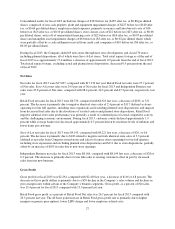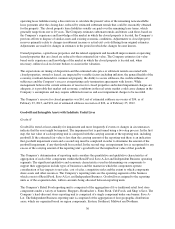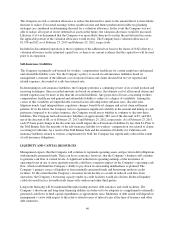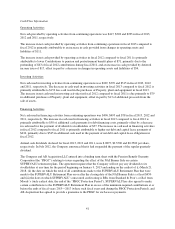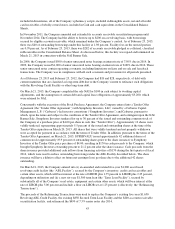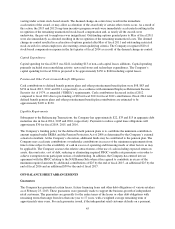Albertsons 2013 Annual Report Download - page 38
Download and view the complete annual report
Please find page 38 of the 2013 Albertsons annual report below. You can navigate through the pages in the report by either clicking on the pages listed below, or by using the keyword search tool below to find specific information within the annual report.operating lease liabilities using a discount rate to calculate the present value of the remaining noncancellable
lease payments after the closing date, reduced by estimated subtenant rentals that could be reasonably obtained
for the property. The closed property lease liabilities usually are paid over the remaining lease terms, which
generally range from one to 20 years. The Company estimates subtenant rentals and future cash flows based on
the Company’s experience and knowledge of the market in which the closed property is located, the Company’s
previous efforts to dispose of similar assets and existing economic conditions. Adjustments to closed property
reserves primarily relate to changes in subtenant income or actual exit costs differing from original estimates.
Adjustments are made for changes in estimates in the period in which the changes become known.
Owned properties, capital lease properties and the related equipment and leasehold improvements at operating
leased properties that are closed are reduced to their estimated fair value. The Company estimates fair value
based on its experience and knowledge of the market in which the closed property is located and, when
necessary, utilizes local real estate brokers to assist in the valuation.
The expectations on timing of disposition and the estimated sales price or subtenant rentals associated with
closed properties, owned or leased, are impacted by variable factors including inflation, the general health of the
economy, resultant demand for commercial property, the ability to secure subleases, the creditworthiness of
sublessees and the Company’s success at negotiating early termination agreements with lessors. While
management believes the current estimates of reserves for closed properties and related impairment charges are
adequate, it is possible that market and economic conditions in the real estate market could cause changes in the
Company’s assumptions and may require additional reserves and asset impairment charges to be recorded.
The Company’s reserve for closed properties was $61, net of estimated sublease recoveries of $34, as of
February 23, 2013, and $74, net of estimated sublease recoveries of $26, as of February 25, 2012.
Goodwill and Intangible Assets with Indefinite Useful Lives
Goodwill
Goodwill is tested at least annually for impairment and more frequently if events or changes in circumstances
indicate that the asset might be impaired. The impairment test is performed using a two-step process. In the first
step, the fair value of each reporting unit is compared with the carrying amount of the reporting unit, including
goodwill. If the estimated fair value is less than the carrying amount of the reporting unit there is an indication
that goodwill impairment exists and a second step must be completed in order to determine the amount of the
goodwill impairment, if any that should be recorded. In the second step, an impairment loss is recognized for any
excess of the carrying amount of the reporting unit’s goodwill over the implied fair value of that goodwill.
The Company’s determination of reporting units considers the quantitative and qualitative characteristics of
aggregation of each of the components within the Retail Food, Save-A-Lot and Independent Business operating
segments. The significant qualitative and economic characteristics used in determining our components to
support their aggregation include types of businesses and the manner in which the components operate,
consideration of key impacts to net sales, cost of sales, competitive risks and the extent to which components
share assets and other resources. The Company’s reporting units are the operating segments of the business
which consist of Retail Food, Save-A-Lot, and Independent Business. Goodwill was assigned to the reporting
units as of the acquisition date, with no amounts being allocated between reporting units.
The Company’s Retail Food reporting unit is comprised of the aggregation of five traditional retail food store
components under a variety of banners: Shoppers, Hornbacher’s, Farm Fresh, Cub Foods, and Shop’n Save. The
Company’s hard-discount stores reporting unit is comprised of a single component under one banner: Save-A-
Lot. The Independent Business reporting unit is comprised of the aggregation of four geographic distribution
areas, which are organized based on region components: Eastern, Southeast, Midwest and Northern.
36



